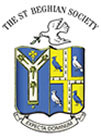|
 |
The Old St Beghian | |
| July 2019 | |||
Then and Now
An OSB recently sent in a series of scans of three school prospectuses he had acquired: one from 1914 and the other two from the 1960s and 1970s. They can be viewed by clicking here on 1914, 1960s or 1970s, but what follows are some of the comments on aspects of them which struck him at a first reading.
“The 1914 brochure is a real work of art, beautifully ornate and coloured, on embossed thick paper and the red finery around the edges is very impressive. It also has a stylish bow or thread to hold it together. Someone has obviously ‘pushed the boat out’ in designing and producing this brochure. I think if I had received something like that in the 1900s, I would have sent my son to the school, though I would probably not have been able to afford it! The 1960s brochure is slightly plainer but still impressive. (The basic fees in 1914 for Cumberland and Westmorland residents were £15 p.a. plus £25/40 extra for boarding etc and for others £21 p.a. with extras again. By the time of the later brochure these had become £432 p.a. for boarding with tuition fees etc. and £210 p.a. for day boys. Ed.)
There are references (to the clothing list in 1914) to ‘drawers if worn’, knickerbockers, nightshirts, and Eton collars. I had not realised that boys in the 1900s did not wear any underwear if they chose! The prospectus also states that ‘Boys are expected to write home at least once a week’ and if the letters are ‘badly spelt or slovenly written’, parents are requested to communicate this fact to the school!”
In addition to the above remarks, your Editor, following a brief glance through, noted that in 1914 the general object of the school (‘mission statement’ in today’s jargon) was ‘to provide a Public School education for those who wish for a smaller or cheaper School than eg Rugby or Clifton’; also that boys were accepted from eight years of age onwards. OSBs will smile at the statement that, in 1914, the ‘Climate is specially suited for delicate boys’, though by the 1960s this had changed to ‘the climate is temperate but bracing’. Interestingly, the major change in the curriculum was a greater emphasis on the sciences by the 1960s.
Home
The St Beghian Society
St Bees School,
St Bees, Cumbria, CA27 0DS.
Tel: (01946) 828093 Email: osb@stbeesschool.co.uk
Web: www.st-beghian-society.co.uk
![]()